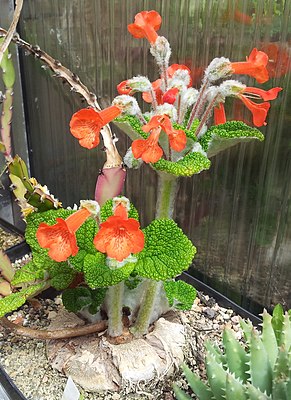Sinningia
| Sinningia | ||||||||||||
|---|---|---|---|---|---|---|---|---|---|---|---|---|

|
||||||||||||
| Systematics | ||||||||||||
|
||||||||||||
| Scientific name | ||||||||||||
| Sinningia | ||||||||||||
| Nees |
Sinningia ( Syn. : Gesnera Martius , Tapina Martius , Megapleilis . Raf , Tapeinotes . DC , Corytholoma Decaisne , Dircaea Decaisne , Ligeria Decaisne , Rechsteineria rule ) is a plant kind from the family of Gesneriad (Gesneriaceae). The genus is named in honor of Wilhelm Sinning (1792–1874), a head gardener in the Botanical Garden of the University of Bonn .
description
Vegetative characteristics

The terrestrial, epiphytic and rock-dwelling species grow as perennial herbaceous plants with bulbous roots that can reach up to 40 centimeters in diameter. The 0.1 to 1.5 meter long annual and upright shoots arise from the underground tuber and are mostly unbranched. If there is no tuber, the shoots are very fleshy at the base. The stalked, elliptical or elongated leaves are downy-haired to tomentose with a notched or serrated edge and are 0.1 to 6 inches long. They are crossed or in groups of three or lively or form a basal rosette.
Generative characteristics
The lateral or terminal inflorescence bears 1 to 10 individual flowers per axilla. The more or less felty, horizontally protruding or rarely hanging flowers have a 0.1 to 15 centimeter long peduncle, but sometimes it is missing. The bell-shaped and five-lobed calyx consists of triangular or lanceolate segments. The tubular or funnel-shaped to bell-shaped corolla is swollen on one side at the base and is 2 to 6 centimeters long. It is colored orange, red, pink or white. The stamens grown together at the base of the corolla have 4 stamens in two pairs each. The nectar disc, reduced to dorsal glands, is bilobed or composed of two or five individual glands. About the half under continuous to upper permanent ovary of just sitting stylus . The scar is mouth-shaped. The dry and more or less conical capsule fruits are rarely fleshy, pointed, two-lobed and are up to 1 centimeter long. The narrow to broadly ellipsoidal seed is light brown in color, striped lengthways and is up to 1 millimeter in size.
distribution
The main distribution area of the genus is in Brazil . However, some species also occur in northern Argentina , Peru , Venezuela or southern Mexico .
Systematics
The genus was established by Nees in 1825 and today includes around 60 species. The type species of the genus is Sinningia helleri Nees .
|
There are many hybrid cultures that are used as ornamental plants.
swell
- A. Chautems: Sinningia . In: Urs Eggli (Hrsg.): Succulent lexicon . tape 2 dicotyledons (dicotyledons). Ulmer, Stuttgart 2002, ISBN 3-8001-3915-4 , p. 298 .
Individual evidence
- ↑ Lotte Burkhardt: Directory of eponymous plant names . Extended Edition. Botanic Garden and Botanical Museum Berlin, Free University Berlin Berlin 2018. [1]
- ^ Christian Gottfried Daniel Nees von Esenbeck: Annales des sciences naturelles . 1825, Issue No. 6, p. 296 ( online ).
- ↑ Species list from Smithsonian National Museum of Natural History, World Checklist of Gesneriaceae, accessed on January 15, 2010
- ↑ a b c d e f g Sinningia in the Germplasm Resources Information Network (GRIN), USDA , ARS , National Genetic Resources Program. National Germplasm Resources Laboratory, Beltsville, Maryland. Retrieved December 2, 2018.
- ↑ a b c d e f Alain Chautems, Thereza Cristina Costa Lopes, Mauro Peixoto & Josiene Rossini: Taxonomic revision of Sinningia Nees (Gesneriaceae) IV: six new species from Brazil and a long overlooked taxon In: Candollea ISSN 0373-2967 , Vol 65, Nº. 2, 2010, pp. 241-266 PDF
- ↑ Ferreira, Gabriel E., Jorge L. Waechter, and Alain Chautems: 2014, Sinningia ramboi (Gesneriaceae), a New Species from South Brazil in Systematic Botany, 39 (3): 975-979.
Web links
- Overview of the genus (Engl.)
- Overview of hybrids as ornamentals (Engl.)






